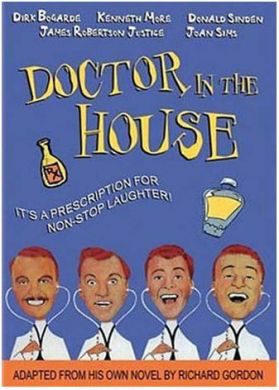
How strange and distant the world of Doctor in the House must appear to the present day generation. It was a world in which medical students purchased skeletons, not laptops; microscopes, not handhelds. They smelled of formaldehyde, dissected cadavers, and performed autopsies. To survive they washed dishes, drove cabs, visited pawnbrokers. Rugby and beer was the mental horizon for many and they often suffered from “hangover vulgaris” after long sessions in pubs that were virtual annexes to the hospital. They were younger, graduating at 23 without colossal debts and mostly going into general practice.
Medical students in the late ‘40s were almost expected to be unruly. They played all kind of pranks, carried off trophies after football matches, and sang bawdy songs on many occasions. They dreaded the final exams, studied episodically, and took caffeine and amphetamines to stay awake. On the wards, the head nurse (sister) ruled absolutely—her main clinical preoccupations being the patients’ temperature and the state of their bowels. Timid nurse probationers in starched uniforms were forever carrying and emptying bedpans. For the nurses make-up was proscribed and the hair had to be tucked tightly inside their caps. They lived in what was referred to as Virgins’ Retreat, were discouraged from having any contact with the students, but usually managed to find opportunities. Students fell in love, some proposed marriage, others preferred a quick conquest.
The attending physicians were gods. The house staff waited for them in the courtyard and deferentially opened the door of their expensive cars. On rounds the ward was a parade ground, where the chief, followed by his retinue, cast the occasional pearl of wisdom to the students and clerks. Teaching was largely at the bedside. Surgery was taught by great men who had made their fortune and charged amply for an appendectomy. On ward rounds they would demonstrate physical signs while paying scant attention to the patient. In the operating room they threw instruments on the floor, complained about the catgut, abused the residents, humiliated the students, or discussed social events with their assistant. The medical wards were full of unhealed peptic ulcers, the surgical of men of stomachs waiting to be excised. Babies were delivered on newspapers by bicycle riding midwives and inexperienced students. At Christmas everybody wore paper hats, the dean carved the turkey clumsily in the middle of the ward, the students put on a show and later hugged the night nurses, who screamed softly so as not to wake the patients.
The Doctor books, for they were others, were a quick entertaining read, wildly popular and later made into movies and television series. They are classics today. They describe a vanished world, less compassionate, more hierarchical, and less bureaucratic; a world long forgotten but less complicated and more affordable than into what it has evolved.
Doctor in the House is the comic novel written by an English surgeon and anaesthesiologist under the pen name Richard Gordon and set in a fictitious teaching hospital in London. It was widely successful when first published in 1952 and especially so when adapted as a movie and later as a television series.

Leave a Reply